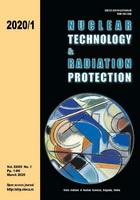
ASSESSMENT OF NATURAL RADIOACTIVITY LEVELS AND RADON EXHALATION RATE POTENTIAL FROM VARIOUS BUILDING MATERIALS
Pages: 64-73
Authors: Ivana S. Vukanac, Marija M. Janković, Milica M. Rajačić, Dragana J. Todorović,
Predrag N. Ujić, Gordana K. Pantelić, Nataša B. Sarap, and Jelena D. Krneta NikolićAbstract
Various imported building materials commonly used in construction and industry in Serbia were analyzed using gamma spectrometry. Based on the activity concentrations of 226Ra, 232Th, and
40K in the investigated samples, radium equivalent activity, Raeq, absorbed dose rate, D, annual effective dose, DE, and the external hazard index, Hex, were calculated to assess the radiation hazard for people. The Raeq for most of the analyzed samples (416 in total) was lower than the maximum admissible value of 370 Bqkg–1 set in the UNSCEAR report. The absorbed gamma dose rate in air was found to vary from 0.030 µGyh–1 to 1.328 µGyh–1 which in some cases exceeded indoor dose rates in Europe. The obtained values for annual effective dose exceed the limits of 0.41 mSv given in literature for about 5 % of measured samples, while values of Hex were higher than unity for three samples of cement, eight samples of granite, and one sand sample.
As a possible source of elevated effective dose, the radon exhalation from building materials was estimated using the parameters given in literature. The internal dose due to 222Rn exhaled from the building material was found to be up to nine times higher than external dose due to
226Ra content in some cases.
Key words: natural radioactivity, radon exhalation rate, radiation hazard indice, building material
FULL PAPER IN PDF FORMAT (298 KB)
